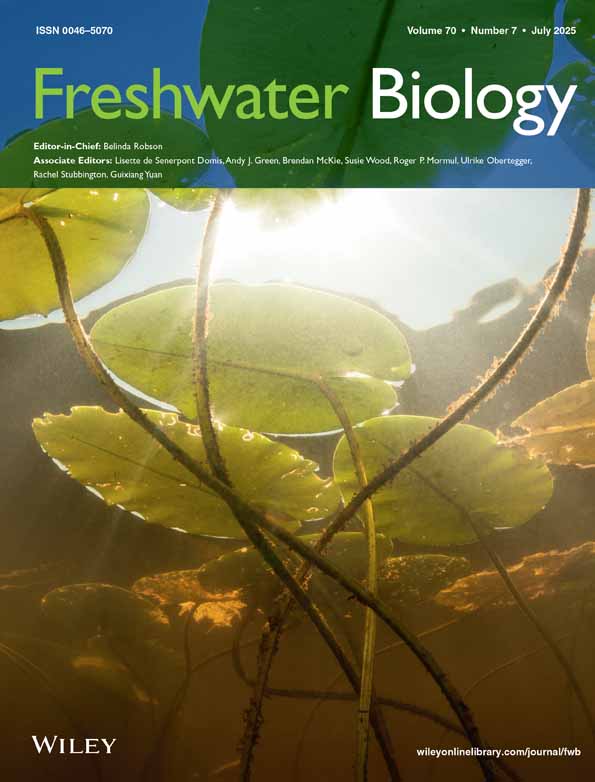
Antagonistic Rewiring and Turnover Patterns in a Neotropical Fish–Parasite Metanetwork
Funding: This study was supported by Coordenação de Aperfeiçoamento de Pessoal de Nível Superior and Conselho Nacional de Desenvolvimento Científico e Tecnológico.
ABSTRACT
- Integrating beta-diversity and network analyses is an emerging approach for understanding the spatial structure of species communities. For instance, although the presence of hosts affects parasite species distribution, environmental factors can either restrict or promote the occurrence of certain parasite species by changing the abundance of suitable hosts or by affecting the free-living stages of some parasite groups. Here, we combined the metacommunity framework with network analyses to address two main questions: (1) How do fish–parasite interactions respond to a longitudinal gradient along a river? and (2) Which ecological descriptors are associated with species' roles in metanetwork connectivity?
- We explored the beta-diversity patterns of fish–parasite interactions along a Neotropical River gradient and analysed how species contribute to the connectivity of the river metanetwork. To achieve this, we investigated the association between network centrality descriptors of fish and parasite species and their ecological and quantitative traits.
- We found a high turnover of both species and interactions along the river's longitudinal gradient, as well as a rewiring of interactions in adjacent river stretches. Different environmental factors shape this gradient, and our results suggest niche-based processes are driving the observed interaction patterns. Interaction turnover was positively correlated with geographical distance, and evidence of rewiring in response to anthropogenic impacts was observed throughout the river.
- The analyses of species roles and their contribution to river connectivity were complementary to the beta-diversity findings, elucidating patterns of parasite sharing along the river. Parasite species with higher mean abundances were more likely to persist across different river stretches, and non-adult parasites had a greater probability of infecting multiple host species. Additionally, fish species belonging to the same taxonomic order and exhibiting similar trophic habits were more likely to share parasite species.
- We demonstrated that fish–parasite interactions follow a deterministic pattern, and as such, habitat changes across river stretches had a stronger influence on the metanetwork than would be expected by chance. These results underscore the importance of preserving the natural gradients of river systems and controlling the anthropogenic pressures that might alter interaction dynamics in aquatic environments.
1 Introduction
Species composition across spatial scales tends to become more dissimilar with increasing geographical distance in both terrestrial and aquatic systems (Nekola and White 1999). In freshwater systems, distance decay patterns are structured along the longitudinal zonation in riverine ecosystems, where species composition, richness and abundance change from upstream to downstream (Araújo et al. 2008; Torgersen et al. 2006). In this context, environmental gradients and geographical distances (López-Delgado et al. 2020) are often correlated, and community assembly is likely driven by environmental filtering rather than neutral processes based solely on species dispersal (Astorga et al. 2012) or ecological drift (Hubbell 2001). Consequently, alterations in environmental gradients due to anthropogenic factors may disrupt expected patterns of species composition and interactions within riverine ecosystems (López-Delgado et al. 2020).
From a niche-based perspective, turnover of fish species along a river's longitudinal gradient is expected, as are corresponding changes in their interactions with parasites (Blasco-Costa et al. 2013). Host density and diversity influence parasite communities, increasing their diversity across river zones and decreasing similarity in their composition from upstream to downstream (Krasnov et al. 2020). Although studies specifically addressing beta-diversity of fish–parasite interactions in riverine ecosystems are scarce, we anticipate that such changes are correlated with fish distribution (Poulin 2003), where widespread and highly-connected species tend to persist, whereas turnover occurs among other species based on resource availability (Araújo et al. 2008).
Environmental factors can also restrict or promote the presence of certain parasite species by affecting the abundance of intermediate and suitable hosts or by affecting the free-living stages of some parasite groups (Bolnick et al. 2020). Consequently, parasite community composition may shift regardless of changes in host populations (Costa et al. 2021). These shifts in host–parasite relationships may occur through the infection of a new parasite species or an increase in parasite sharing, that is, the sharing of the same parasite species by different host species (Bellekom et al. 2021; Runghen et al. 2021). In this context, we may expect not only interaction turnover but also interaction rewiring—changes in host–parasite associations across the river while the overall composition remains relatively constant (Poisot et al. 2012).
Here we apply a metacommunity framework to investigate the spatial structure of host–parasite interactions along a longitudinal river gradient, considering potential environmental factors that influence the dispersal of local communities, with a focus on metazoan fish parasites (Heino 2013; Leibold et al. 2004; Winegardner et al. 2012). Specifically, we assessed the beta-diversity of interactions (Almeida and Cetra 2016; Garcia et al. 2023; Torgersen et al. 2006; Villéger et al. 2013) using a metanetwork approach, which captures how the structure of ecological interactions is shaped at the metacommunity level (Li et al. 2020). A metanetwork comprises a set of local networks connected by species movements and interactions across a spatial gradient (Emer et al. 2018; Tylianakis and Morris 2017). This approach enables us to uncover patterns of host–parasite interactions along the river and elucidates the parasite transmission and infection processes by identifying the spatial structure of parasite–host networks within a metacommunity context (Dallas and Presley 2014; Poisot et al. 2012).
In addition to interaction structure, the role of individual species within the metanetwork may vary with changes in host–parasite diversity along the river gradient, potentially affecting their importance for network connectivity (Bellekom et al. 2021; Dallas et al. 2019). Quantifying species importance within and across local networks allows for the identification of traits associated with parasite sharing (Dallas et al. 2019). Since interactions are ultimately shaped by species traits, those with similar traits are more likely to share parasites species. Likewise, species that occupy central positions in ecological networks tend to interact with a greater number of partners, acting as bridges between otherwise disconnected groups (Jordán et al. 2006).
Parasite-sharing events can involve a single parasite species infecting multiple host species within and across river stretches. Conversely, a single host species may harbour different parasite species along the river gradient, leading to variation in parasite composition across its populations. Examining the roles of parasite species may identify traits related to exploitation strategies and environmental adaptability that influence their infection probability (Brooks et al. 2019). Indeed, parasite prevalence, abundance and host body size have been previously linked to centrality in ecological networks (Pilosof et al. 2015; Romano et al. 2016). Thus, we aim to investigate how host–parasite metanetwork connectivity is structured along a coastal river that originates in the Atlantic Forest and flows through pristine, anthropogenic and mangrove areas (Galvanese et al. 2022). The Guaraguçu River provides a heterogeneous environmental gradient shaped by contrasting anthropogenic pressures, offering an ideal system to explore the structure of fish–parasite interactions and the role of fish species in maintaining river connectivity (Tylianakis and Morris 2017) and, in the case of parasites, their role in transmission dynamics (Bellekom et al. 2021).
We examined the beta-diversity of interactions and the importance of species connectivity to describe how a fish–parasite metanetwork is structured along the Guaraguaçu River, Brazil. To assess the importance of host and metazoan parasite species in metanetwork connectivity, we used two sets of network descriptors: the betweenness centrality index and species roles within and between river stretches (Dallas et al. 2019; Li et al. 2020). Betweenness centrality measures the importance of a species within a network by quantifying how often it lies on the shortest paths between other species pairs. Species roles, in turn, reflect their function in connecting modules within the network, where modules are subsets of species that interact more frequently with each other than with the rest of the community (Jordán et al. 2006; Olesen et al. 2007). Specifically, we address two main questions: (1) How do host–parasite interactions respond to the river environmental gradient? We anticipate that both species distribution and interactions respond in a ‘niche-deterministic’ manner, with a high turnover of species and interactions along the river. (2) Which traits and ecological descriptors are associated with a species' contribution to the structure of the metanetwork? We expect fish and parasite ecological descriptors, such as fish trophic class, body size and habitat use, as well as parasite transmission mode, developmental stage and prevalence—will be associated with species connectivity roles and centrality in the network.
2 Methods
2.1 Study Area and Data Sample
The Guaraguaçu River is one of the main rivers in the Coastal Basin of the Paraná State, southern Brazil. Its source lies in pristine mountainous fragments of the Atlantic Forest, and its mouth is located in the Paranaguá Bay, an area characterised by an extensive and well-preserved mangrove forest (Galvanese et al. 2022; da Silva 2008). The river belongs to the Lagamar estuarine complex, recognised as a Biosphere Reserve and World Heritage Site within the Atlantic Forest. The river is approximately 60 km long, with a regular flow during ebb tide and reverse flow during high tide. This pattern brings an inverted flow dynamic twice per day, depending on the tide cycle. To reflect the spatial and environmental heterogeneity along the river, we defined four distinct sectors following the continuous distance of the river. The sectors were established based on a combination of longitudinal distance and environmental characteristics, starting from the most upstream navigable portion and extending to the last freshwater aquatic macrophyte occurrence. Each sector sampling spans 4–5 km of the river's course (see Figure 1) and is separated by a minimum linear distance of 4 km. The total sampled length was 34.5 km, equivalent to just over 50% of the river's total length. The maximum linear distance, that is, Euclidean distance, between the first and last sectors is 13 km (Figure 1).
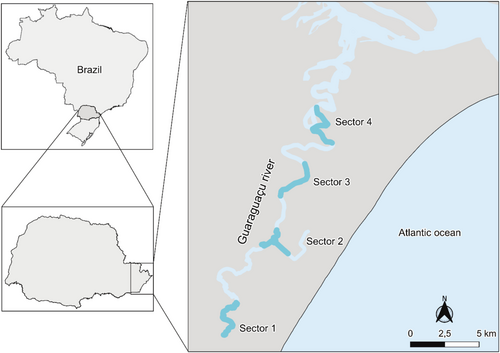
The river's so-called ‘sectors’ differ from each other in a set of environmental features related to both natural ecological gradients and anthropogenic influences. The first sector, located in the upstream part, has a very conserved and pristine environment. Its margins are dominated by the locally endangered tree species Tabebuia cassinoides (Lam.) DC., and the river width ranges between 10 and 15 m. The following sectors are more influenced by opposing water flow directions (counterflow) and fluctuating water levels due to daily tidal effects, which have a greater impact on aquatic macrophyte banks (see also Galvanese et al. 2022). The second sector is subjected to strong anthropogenic pressures, including two artificially modified channels: one for water supply and another (paradoxically) for sewage effluent discharge. The third sector lies within the Guraguaçu River Ecological Station, an ecological restoration unit. Although protected, it still reflects upstream impacts, with biotic and abiotic indicators of eutrophication (e.g., Galvanese et al. 2022). Fourth Sector is near the river mouth, with an extensive and well-preserved mangrove ecosystem, strong tidal influence and higher salinity (Galvanese et al. 2022; da Silva 2008) (Figure 1). Abiotic variables were measured during each sampling to confirm and better relate the sector's distinctions (Table S1).
The fish sampling was carried out by the Guaraguacu River Monitoring Project, which employs a standardised and comparable sampling design across all four sectors (see <https://lasbufprbio.wixsite.com>). Ichthyofauna sampling surveys were made with the use of 10 gillnets of 20 m, two for each size (2, 4, 6 and 8 cm between consecutive knots) and 10 modified fish traps (an adaptation of drum nets, 2 of 20 m long, 0.8 m height and 3 cm mesh, 8 of 0.8 m long, 0.45 height and 3 cm mesh) in each sector, to capture individuals of all sizes (see Moraes et al. 2024 for a full description). Nets were arranged in pairs: one was placed in a non-native aquatic macrophyte bank and the other in the closest native bank. In sectors without non-native macrophytes (i.e., sectors 1 and 4), gillnets and traps were placed in native macrophyte banks and adjacent structured microhabitats. This strategy aimed to maximise fish diversity, as aquatic macrophytes are ecosystem engineers that influence fish assemblages (Carniatto et al. 2013).
Fish sampled were brought to the laboratory, where they were identified, measured (total and standard length in centimetres), and weighed (grams). Biometric data were taken, and fish were dissected. Individuals' organs were removed, and the gills, visceral cavity and other organs were examined under a stereoscopic microscope for metazoan parasites. Fish sex and gonadal maturation were identified whenever possible. Parasites were fixed and processed following the protocol established by Eiras et al. (2006), and identified using the following taxonomic literature: Kohn et al. (2006, 2007) for Monogenean and Trematoda, Thatcher and Boeger (1984a, 1984b) for Copepoda, Thatcher and Varella (1981) for Trematoda, Thatcher (2006) and Moravec (1998) for Nematoda.
To build the ecological networks under a metacommunity framework, we focused on fish species with an average total length higher than 10 cm and a minimum dispersal capacity along the river. This approach resulted in a total of 159 individuals, summarised in 12 fish species, from an initial pool of 21 species sampled in the monitoring program. We identified 68 different species of parasites (36 species of ectoparasites and 32 species of endoparasites) in the Guaraguaçu River (for more information on the parasite diversity, see Moraes et al. 2024). Of the fish sampled, 32 individuals were sampled in Sector 1, 42 in Sector 2, 38 in Sector 3 and 47 in Sector 4 (Moraes et al. 2024) (Table S2). The average total length of fish populations ranged from 10.5 to 51.8 cm.
2.2 Fish Traits and Parasite Quantitative Descriptors
Fish trait information was gathered from the fishbase.org database (Froese and Pauly 2000), including: taxonomic order and family, trophic class (omnivorous, piscivorous, zoo-benthivores, zoo-planktivorous) and level, habitat in the water column (demersal, benthopelagic, reef-associated), schooling behaviour (present or absent) and migratory behaviour (present or absent). Additionally, the mean total length and weight were estimated for each fish species sampled. Parasite species were categorised by their parasitism form (ecto- or endoparasites), taxonomy group (Acanthocephala, Cestoda, Copepoda, Digenea, Monogenea, Nematoda), development stage (adult or intermediary) and mode of transmission (trophic or by direct contact). We also calculated quantitative descriptors for each parasite species: number of host individuals infected, total and maximum prevalence and mean abundance.
The total prevalence was defined as the number of host-infected individuals divided by the total number of host individuals sampled in the river (Bush et al. 1997). Maximum prevalence was calculated as the proportion of infected individuals within a given host species. Parasite's mean abundance was obtained by dividing the overall number of individuals of each parasite species by the number of infected hosts based on all interactions in the river (Bush et al. 1997).
2.3 Metanetwork Structure and Analysis
We constructed the metanetwork using two complementary approaches: First, we examined the network of each sector separately, with host and parasite species connected by parasite frequency. For this, we created four binary matrices (A), one for each sector, where rows represented fish species and columns represented parasite species. The value indicated the frequency of each parasite species in each sampled fish species. These matrices were used to asses the role of species, as described below. Second, we created a single binary matrix (A) in which each row represented a fish species population in a specific sector (i.e., if a fish species was found in three distinct sectors, it would appear three times as separate rows). Columns represented parasite species and denoted the total number of individuals of parasite j found in host i in that specific sector. This approach allowed us to incorporate spatial structure, with widespread fish species appearing more than once in the interaction matrix. The interaction links, represented by parasite frequency, indicated the sum of specimens of each parasite species found in a host in a specific river sector. A visualisation of the network framework is provided in Figure S1. The metanetwork was used to calculate betweenness centrality values.
We calculated betweenness centrality to assess the central species of hosts and parasites within the metanetwork (Dallas et al. 2019; Rushmore et al. 2017). Betweenness centrality quantifies how often a node lies on the shortest path between two other nodes (Jordán et al. 2006). In our context, parasite species with high betweenness would bridge different host species or river sectors, serving as a proxy for spillover—the infection of parasites in new host species. Hosts with high betweenness values may have broader spatial distribution or act as hubs for parasite sharing along the river (Dallas et al. 2019). Centrality values were computed using ‘igraph’ package (Csardi and Nepusz 2006) in R software (R Core Team 2023).
To explore how species centrality is shaped by biological traits, we analysed the relationship between fish and parasite betweenness centrality and their descriptors using generalised linear models (GLMs). First, we conducted a correlation analysis between host and parasite predictor variables (Figures S2 and S3). Subsequently, we generated a model selection table using ‘MuMIn’ package (Bartoń 2023). The best model for each metric was chosen based on weight and AIC values. Model validation was performed using the ‘Dharma’ package (Hartig 2022), employing the ‘simulateResiduals’ and ‘testDispersion’ functions (Figures S6 and S7). All GLMs were conducted using the ‘lme4’ package (Bates et al. 2015) in R (R Core Team 2023).
We further assessed how fish and parasite traits relate to connectivity roles across river stretches using redundancy analysis (RDA). This method combines multiple regression with a principal components analysis to identify which trait combinations best explain the connectivity metrics (Legendre and Legendre 2012). We selected the most important traits using forward model selection. The significance of the RDA was assessed through 999 permutations. This analysis was conducted using the ‘vegan’ package (Oksanen et al. 2022).
2.4 Interactions and Species Beta Diversity
We assessed interaction beta-diversity across sectors using the framework proposed by Poisot et al. (2012) index, where βwn = βst + βos, with βwn representing the total dissimilarity in the network. The index uses βst, dissimilarity in interaction structure introduced by dissimilarity in species composition (turnover); and βos dissimilarity of interactions of shared species (rewiring).
These indices were compared to null models where sector identities of interactions were reshuffled to test whether observed dissimilarities deviated from random expectations. Significance was evaluated using analysis of variance (ANOVA). All beta-diversity metrics were calculated with the ‘betalink’ package (Poisot 2016), and their relationships with geographic distance were tested using linear models implemented in R.
3 Results
3.1 Beta Diversity of Interactions
Local networks within river sectors exhibited distinct structures and species compositions. In sector one, interactions were observed between 4 fish species and 21 parasite species; in sector two, 5 fish species and 22 parasite species; in sector three, 7 fish species and 29 parasite species; and in sector four, 9 fish species and 47 parasite species.
Host–parasite interactions and species composition varied along the river more than expected by chance (F = 101.9, p-value < 0.001, F = 8.62, p-value = 0.003) (Figure 2), with a higher turnover βst driven by shifts in species composition across sectors. Both interaction turnover and rewiring were significantly related to geographical distance, where βst increased with the βst distance (Adjust-r2 = 0.79, p-value = 0.018) and βos decreased with the βos distance (Adjust-r2 = 0.84, p-value = 0.01) (Figure 3).
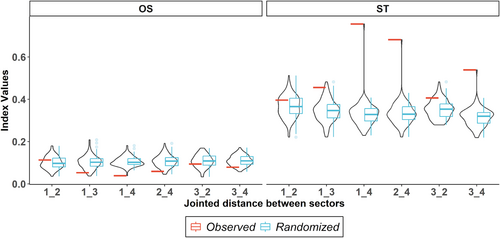
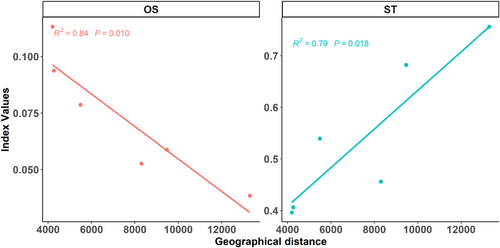
3.2 Connectivity Role of Fish and Parasites Across the Guaraguaçu River
Based on the within and among sector connectivity scores, we classified fish and parasite species according to their roles across the guaraguaçu river sectors (Figure 4). River hub species exhibited both within-sector and among-sector connectivity values higher than expected by chance, indicating a central role in connecting the river network. Fish identified as river hubs included: G. iporangensis, Hoplias malabaricus and R. quelen, along with the parasites Contracaecum sp., Ergasilus sp. and Diplostomidae. Additionally, river connector species, which occur across all sectors and link the metapopulations through their interactions, were exclusively parasite species. Sector hub species are the ones with high interaction intensity inside the local network but lower connectivity among sectors. Fish identified as sector hubs included Centropomus parallelus, G. genidens and Mugil curema, as well as the monogenean species Urocleidus cuiabai (Figure 4).
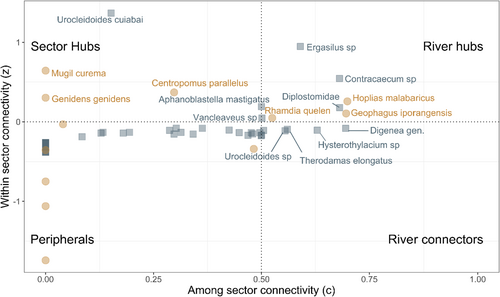
The best descriptors related to fish connectivity roles were their taxonomic order, body length and trophic category, with the redundancy analysis (RDA) explaining 27% of the variance. For parasites, the number of infected host species, mean abundance and developmental stage were the most relevant descriptors, explaining only 7.6% of the variance (Figure 5). Further explanations of terms and axis interpretation can be found in Tables S4 and S5.
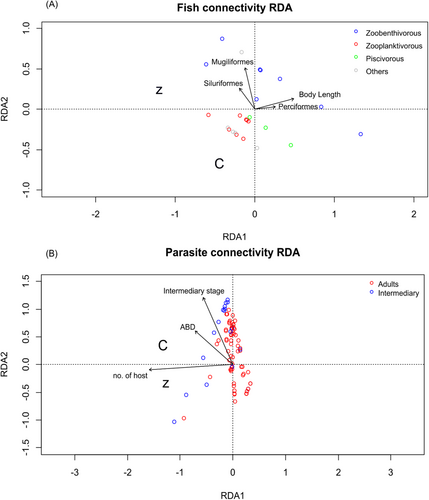
3.3 Metanetwork Structure and Centrality
The river metanetwork comprises 25 fish populations, spanning different species and/or sectors, interacting with 68 parasite species, as depicted in Figure S1. The best descriptors of fish centrality within the metanetwork were their body weight and taxonomic order (GLM t-value = 2.45, p-value = 0.02 and t-value = −1.98, p-value = 0.06, respectively) (Figure 6). Notably, Rhamdia quelen (Quoy & Gaimard, 1824) and Genidens genidens (Cuvier, 1829), both from the order Siluriformes, along with Geophagus iporangensis Haseman, 1911 and Bairdiella ronchus (Cuvier, 1830), exhibited the highest centrality values (Figure S4).

For parasite species, the descriptors most strongly associated with metanetwork centrality were developmental stage and total prevalence (t-value = 2.13, p-value = 0.05 and t-value = 1.9, p-value = 0.07*, respectively) (Figure 7). High centrality values were observed for Contracaecum sp., Nematoda gen1. sp., Diplostomidae and Hysterothylacium sp., all of which were in intermediate developmental stages. Additionally, the copepod Ergasilus sp. Nordman, 1832 presented a high centrality within the metanetwork (Figure S5).
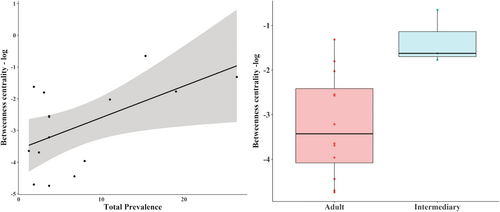
4 Discussion
By integrating the metacommunity framework with network analyses, we can elucidate the factors influencing community structure and assess how spatiotemporal gradients affect species distribution and network connectivity (Poulin and McDougall 2022; Runghen et al. 2021). Despite the limited number of sampling points, our results reveal a tendency for changes along the longitudinal river gradient, likely influenced by anthropogenic impacts previously described in the region (Lula Costa et al. 2023). These findings contribute to identifying spatial patterns in species interactions and provide insights into the factors shaping the species centrality within fish–parasite networks.
In line with our predictions, we observed a niche-deterministic pattern in both species and interaction distributions, marked by a substantial turnover along the river gradient. Additionally, we identified interaction rewiring between geographically close sectors. Although species turnover was already expected, with few species occurring across all river sectors and the increase in species diversity along the river (Araújo et al. 2008), the observed rewiring, suggesting parasite spillover along the river gradient, was not anticipated. Interaction turnover may be linked to the natural salinity gradient of the Guraguaçu River, which influences both species distributions and their interactions (Galvanese et al. 2022). However, anthropogenic pressures, particularly in the river's intermediate sectors, likely play a significant role in the observed interaction rewiring (McLeod et al. 2020).
In this context, species centrality can help us understand patterns associated with parasite sharing and spillover processes that are crucial for interaction rewiring within host–parasite networks (Poulin and McDougall 2022). Parasite species with higher centrality tended to switch hosts or infect multiple populations of the same host species along the entire river gradient, reinforcing their role in maintaining connectivity within the metanetwork (Krasnov et al. 2024). We found that these species were often non-adult stages and/or had higher prevalence rates, consistent with recent findings (Poulin and McDougall 2022). This trend was reinforced by the connectivity roles of parasites, as river hubs and connector species were frequently observed in non-adult stages. Non-adult parasites are known for their generalist host preferences and employ diverse strategies that facilitate their distribution across multiple host species and populations (Bellay et al. 2013).
In addition to non-adult parasites, monogeneans and copepods (Figure S5) infected fish species widely distributed, demonstrating a strong relationship between host and parasite centrality. Their high infection rates also indicate high fitness performance (Felix et al. 2022). Although ectoparasite infections have been previously linked to host distribution (Berkhout et al. 2019), environmental variation better explains their success (Jerônimo et al. 2022; Lafferty 2008). This highlights the parasite's ability to exploit both hosts and environmental conditions, particularly in the case of ectoparasites directly influenced by environmental changes (Lula Costa et al. 2023). Conditions, such as the increased organic nutrient loads create opportunities for species fitness enhancement and exploitation, ultimately increasing the probability of spillover events (Budria 2017; Cai et al. 2018).
A clear example of a possible outcome from the anthropogenic gradient in the Guaraguaçu river is the copepod Ergasilus sp., the only species identified as a river hub. This copepod exhibited its highest prevalence in H. malabaricus, the most widespread host, but also infected other fish species at a lower prevalence, potentially indicating spillover facilitated by favourable environmental conditions (Brooks et al. 2019). However, the occurrence of Ergasilus sp. on multiple hosts may reflect its generalist tendencies rather than active host switching (the evolutionary shift to a new host). Although most Ergasilidae species exhibit some degree of host preference, the family includes species with a wide range of host specificity, with some known to infect up to 15 different fish families (Kvach et al. 2021). Confirming the generalist nature of this species and its successful establishment on other suitable hosts would require more detailed ecological and genetic evidence (Araujo et al. 2015).
Relatedly, fish with higher centrality values shared more parasites with other host species (Rushmore et al. 2017). This pattern aligns with their taxonomic identity and trophic category (Figure S3), reflecting a global trend in which habitat use and host family are among the strongest predictors of host centrality (Dallas et al. 2019). Among the fish species with the highest parasite sharing, those belonging to the Siluriformes order stood out. The species G. barbus and G. genidens, which are from the same genus, are expected to share more parasites (Lima et al. 2016). Genidens is an estuarine fish typically found in river stretches with higher salinity levels, whereas Rhamdia shows decreased abundance in these areas (Silva Junior et al. 2013; Schulz and Leuchtenberger 2006). Nevertheless, some parasites infecting R. quelen were also found in Genidens species. This overlap is consistent with the trophic category of these fish (primarily zoobenthivorous), which facilitates the exchange of parasites, primarily nematodes in their larval stages (Lima et al. 2016).
Higher centrality values were also observed in other zoobenthivorous fish species, including C. parallelus and B. ronchus, all located in river stretches near the mouth. Although the trophic category was not directly related to fish centrality, it was associated with fish connectivity roles. Specifically, the RDA (Figure 5) showed a relationship between within-sector connectivity (z-values) and zoobenthivorous feeding habits, allowing the classification of sector hub species. Fish species with a higher number of interactions within each sampled river sector exhibited higher within-sector connectivity values, indicating that diet plays a central role in parasite transmission at local spatial scales, but not necessarily at the metacommunity level (Bolnick et al. 2020).
Analysing fish and parasite connectivity patterns highlights that host and parasite traits must be considered together, as transmission depends on their interaction (Poulin and Leung 2011). For instance, fish body size, a key factor in both individual-based and multi-species networks (Pilosof et al. 2015; Rivera-Parra et al. 2017), can influence predation susceptibility, with smaller fish being more likely to be predated. This increases the parasite's chances of infecting its final hosts, leading to a higher proportion of non-adult parasite infections (Poulin and Leung 2011). Conversely, hosts with larger body sizes may be more susceptible to contact-transmitted infections due to their size and activity levels (Downs et al. 2019). Ultimately, integrating species traits with ecological and spatial factors is key for a comprehensive understanding of interaction dynamics and parasite distribution (Krasnov et al. 2024).
Here we argue that the use of beta diversity and centrality measures, along with species role analysis, provides complementary insights (see also Dallas et al. 2019). Changes in turnover and interaction rewiring do not capture the importance of a species within each local community. By combining these approaches, a more precise understanding of how communities react to environmental or spatial gradients can be achieved. Understanding changes in host–parasite interactions across such gradients is crucial given the emergence of diseases that threaten the health of both wildlife and humans (Brooks et al. 2019). Indeed, our results reinforce that anthropogenic pressures in riverine systems can enhance parasite performance and increase spillover opportunities, a pattern already documented in the literature (McKenzie and Townsend 2007). Despite the limited number of sampling points along the river, we managed to observe a longitudinal trend in dissimilarity not only in species composition but also in interactions, in line with previous studies describing metacommunity patterns in the same river (Galvanese et al. 2022). Furthermore, we demonstrated that fish–parasite interactions follow an environmentally deterministic pattern, indicating that changes in habitat conditions along the river gradient can significantly influence the structure of the metanetwork.
Author Contributions
Conceptualisation: A.P.L.C. and A.A.P. Developing methods: A.P.L.C., P.R.G.J. and A.A.P. Data analysis: A.P.L.C. Preparation of figures and tables: A.P.L.C. Conducting the research, data interpretation and writing: A.P.L.C., P.R.G.J. and A.A.P.
Acknowledgements
A.A.P. acknowledges the Brazilian National Council for Scientific and Technological Development (CNPQ) for continuous financial support (Process number of current researcher scholarship: 308648/2021-8, see funding information for previous supports in https://lasbufprbio.wixsite.com/home); A.P.L.C. also acknowledges the Brazilian Coordination of Superior Level Staff Improvement (CAPES) for student scholarship (financial code 001). The Article Processing Charge for the publication of this research was funded by the Coordenação de Aperfeiçoamento de Pessoal de Nível Superior - Brasil (CAPES) (ROR identifier: 00x0ma614).
Conflicts of Interest
The authors declare no conflicts of interest.
Open Research
Data Availability Statement
The data and code of this study are openly available in Figshare at https://doi.org/10.6084/m9.figshare.25423519.v1.



